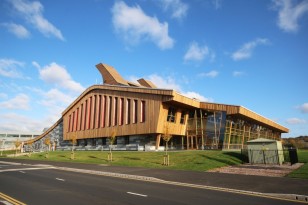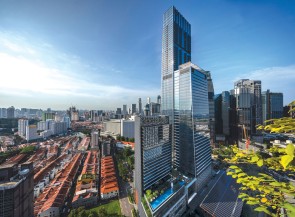
Blog / Sustainable Construction
Building Rehabilitation: 5 Success Stories
Categories
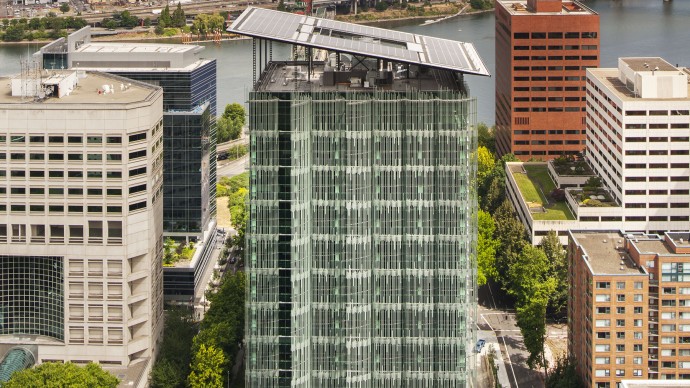
The greenest building is the one that is already built.
- Carl Elefante, FAIA, FAPT
Defining Building Rehabilitation: An Overview
Building rehabilitation, in essence, can be defined as the process of restoring or improving the structural integrity and energy performance of an existing building while retaining its historic significance.
This elaborate process involves diagnosing the current conditions, identifying opportunities for enhancement, developing an efficient plan, and executing it with practicality and sustainability.
The aim is not just to increase the lifespan of a building, but also to make it more energy-efficient, comfortable, and sustainable for future use.
Among other things, it involves the following processes:
- Diagnosing the current conditions: This involves a thorough examination of the building structure, systems, thermal comfort, and energy performance. Evaluating these elements provides a clearer understanding of what needs to be improved or modified.
- Identifying opportunities for enhancement: After the diagnosis phase, it becomes essential to identify the areas where modifications can result in higher energy savings, increased comfort, and improved overall building performance.
- Developing an efficient plan: Based on the diagnosis and opportunities identified, a rehabilitation plan is created to ensure maximum energy performance. This could involve strategies like transitioning to renewable energy resources, reducing energy loads, improving insulation, retrofitting with energy-efficient systems, etc.
- Executing the plan: After the rehabilitation strategy has been mapped out in detail, it is then executed step by step, ensuring that it stays within the designed parameters and budget.
Building rehabilitation is an indispensable part of sustainable architecture. It brings together the expertise of architects, construction professionals, and energy experts to reduce the environmental impact of buildings while conserving our architectural heritage. With advances in technology and building science, today's rehabilitated buildings are far more energy-efficient and climate-responsive compared to those built in the past.
Exploring the Importance of Energy Efficiency in Building Rehabilitation
Energy efficiency has emerged as a central objective in the modern architecture and construction industry. By understanding how buildings consume energy, and by making purposeful design and function modifications, we can rehabilitate existing structures to drastically reduce their energy consumption and environmental impact. Let's delve deeper.
Energy-efficient building rehabilitation focuses on assessing and modifying the existing energy consumption pattern of a building. It involves deploying either active or passive strategies, or even a combination of both, to ensure a significant reduction in the building's overall energy consumption. These strategies will further be discussed in later sections.
Such streamlined interventions not only reduce the building's carbon footprint, but also significantly decrease operation costs. By implementing energy-saving measures, building owners can enjoy substantial cost savings over time, contributing to a building's long-term financial sustainability.
Moreover, energy-efficient rehabilitation can remarkably improve the comfort level within the building. From optimal temperature control to better indoor air quality, occupants can enjoy an enhanced living or working environment, thereby improving their productivity and overall quality of life.
Contrary to popular belief, building rehabilitation doesn't always involve extensive renovations. Often, simple modifications such as lighting upgrades, insulation additions, window replacements, or HVAC system overhauls can lead to significant energy efficiency improvements.
Understanding the building's energy performance is crucial for devising an effective rehabilitation strategy. Energy modelling tools play a fundamental role in enabling this understanding, offering in-depth insights into the building's energy consumption pattern. Energy Certificates, on the other hand, validate a building's energy performance against recognized standards, thereby ensuring its compliance with energy regulations and guidelines.
Last but not least, a circular construction approach is advocated to ensure that the building resources are managed in a more sustainable manner. By recycling and reusing materials, adopting modular design principles, and optimising deconstruction processes, a building's life cycle can be extended, thereby minimising the extraction of new materials and reducing waste. Added to an energy-efficient rehabilitation strategy, this can mean a double victory for sustainability.
In summary, energy efficiency should be viewed as a critical component of building rehabilitation. It results in cost savings, enhances building function, and helps to safeguard our environment for future generations. So, why not align your rehabilitation project with these transformative technologies and make a positive impact?
Building Rehabilitation: Active vs. Passive Strategies
Deciding between active or passive strategies in the rehabilitation process requires a solid understanding of each. As you may know, active strategies often involve the usage of mechanical systems or advanced technologies to control the building's environment, such as high-efficiency HVAC systems, enhanced insulation materials, low-emission window glasses, photovoltaic panels, etc.
On the other hand, passive strategies revolve around strategic design principles and natural resources to achieve a comfortable building environment. This could include the building's orientation, window placements for natural light harvesting, an extensive use of vegetation for natural cooling, or thermal mass utilisation, for instance.
At a glance, active strategies offer precise control over the building's environment, showing faster results in energy conservation. Nonetheless, they can entail more upfront costs or ongoing maintenance. Passive strategies, whereas, may take longer to realise noticeable changes in energy savings, as they rely significantly on natural elements, but the operating and maintenance costs are typically lower.
The choice between active and passive strategies for your building rehabilitation largely depends on the specific characteristics and needs of the building, as well as the project's budget, timeline, and long-term sustainability goals. One strategy is not inherently better than the other; it's about finding the right balance.
- Active rehabilitation strategies: high upfront costs, offers precise control, sees faster results, but higher running costs
- Passive rehabilitation strategies: lower upfront costs, lower operational costs, utilises natural resources, but may result in slower improvements
It's also important to mention that a combination of active and passive strategies is often the key to creating the most energy-efficient and sustainable buildings. This is particularly true for larger commercial or institutional buildings where the energy loads tend to be higher.
Energy Modelling and Analysis in Building Rehabilitation
Energy modelling is a vital step while deciding active vs. passive strategies. It involves creating a computer model that simulates the energy use of the building based on various parameters like its geometry, building envelope properties, HVAC systems, lighting, occupancy, and operating schedules.
With such a model, you can evaluate the building's current energy performance, identify energy inefficiencies, and predict how different rehabilitation strategies - be it active or passive - might affect this performance.

Energy Modelling Components
- Geometry: This refers to the building’s physical dimensions and shape, including its size, orientation and layout.
- Building Envelope Properties: These include the thermal characteristics of the building's exterior walls, roof, windows, doors, etc.
- HVAC systems: This includes the building's heating, ventilation, and air-conditioning systems.
- Lighting: This encompasses natural and artificial lighting and their relevant controls within the building.
- Occupancy patterns: How many people use the building, when, and where significantly influence energy usage.
- Operating Schedules: This includes when different building systems and lights are turned on and off based on typical building use.
Energy modelling hence becomes a powerful tool for architects and construction professionals to predict, strategize, and implement an optimal mix of active and passive rehabilitation strategies for buildings, thus achieving sustainable, long-term energy efficiency.
1. The Wilmcote House Project, UK
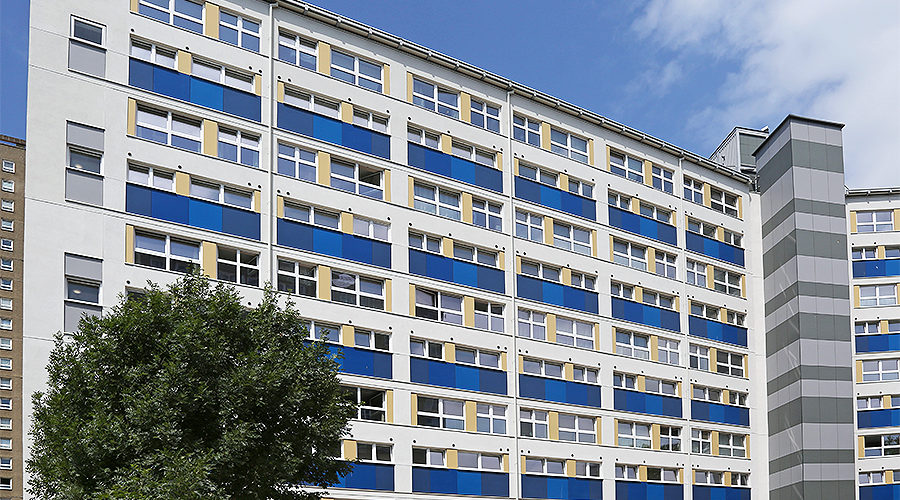
The Wilmcote House is a high-rise residential building in Portsmouth, UK, built in the 1960s and 1970s. The building required significant improvements to ensure quality of life for its residents.
Across a four-year program, over 100 residences within Wilmcote’s three 11-storey blocks were set for upgrades to provide comfortable, safe and thermally-efficient homes for residents that will endure for years to come.
The renovation was designed and led by ECD Architects, and the whole-building EnerPHit solution centred on deep retrofit.
The super-insulation of Wilmcote House involved a combination of several products and systems, including a Rockpanel-cladded facade system and a combination of ROCKWOOL external wall and flat-roof insulation together with a selection of the company’s fire-stopping and fire-protection products. The ROCKWOOL external insulation was fitted as a 300/400mm zone fixed to newly-assembled, external steel frames to insulate and wrap the entire building.
The result is improved thermal performance and enhanced airtightness, reducing draughts, condensation and mould growth.
2. The Shanghai Tower, China
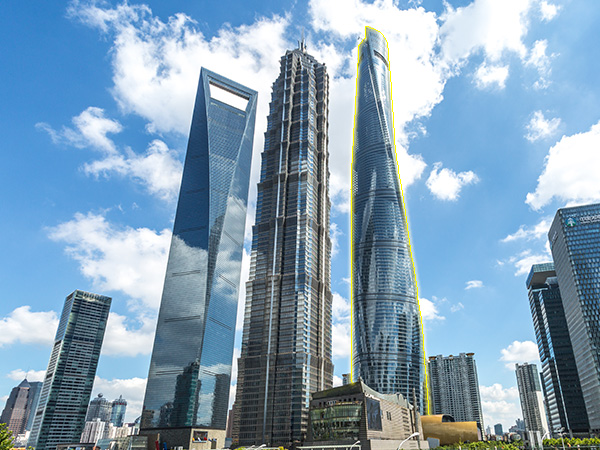
The Shanghai Tower is a 632-metre (2,073 feet) spiralling skyscraper in Lujiazui commercial district, Shanghai, China.
The tower’s curved design minimises the force of heavy winds, allowing it to withstand winds up to 114 miles per hour. The building also has several green features such as a double-skin, which keeps the building cool in the summer and warm in the winter, vertical axis wind turbines and geothermal coupling. The Shanghai tower will have office spaces across nine distinct indoor zones with atriums featuring gardens, restaurant and cafes, in addition to retail space, a public observatory, a luxury hotel and underground parking.
3. Edith Green-Wendell Wyatt Federal Building, USA
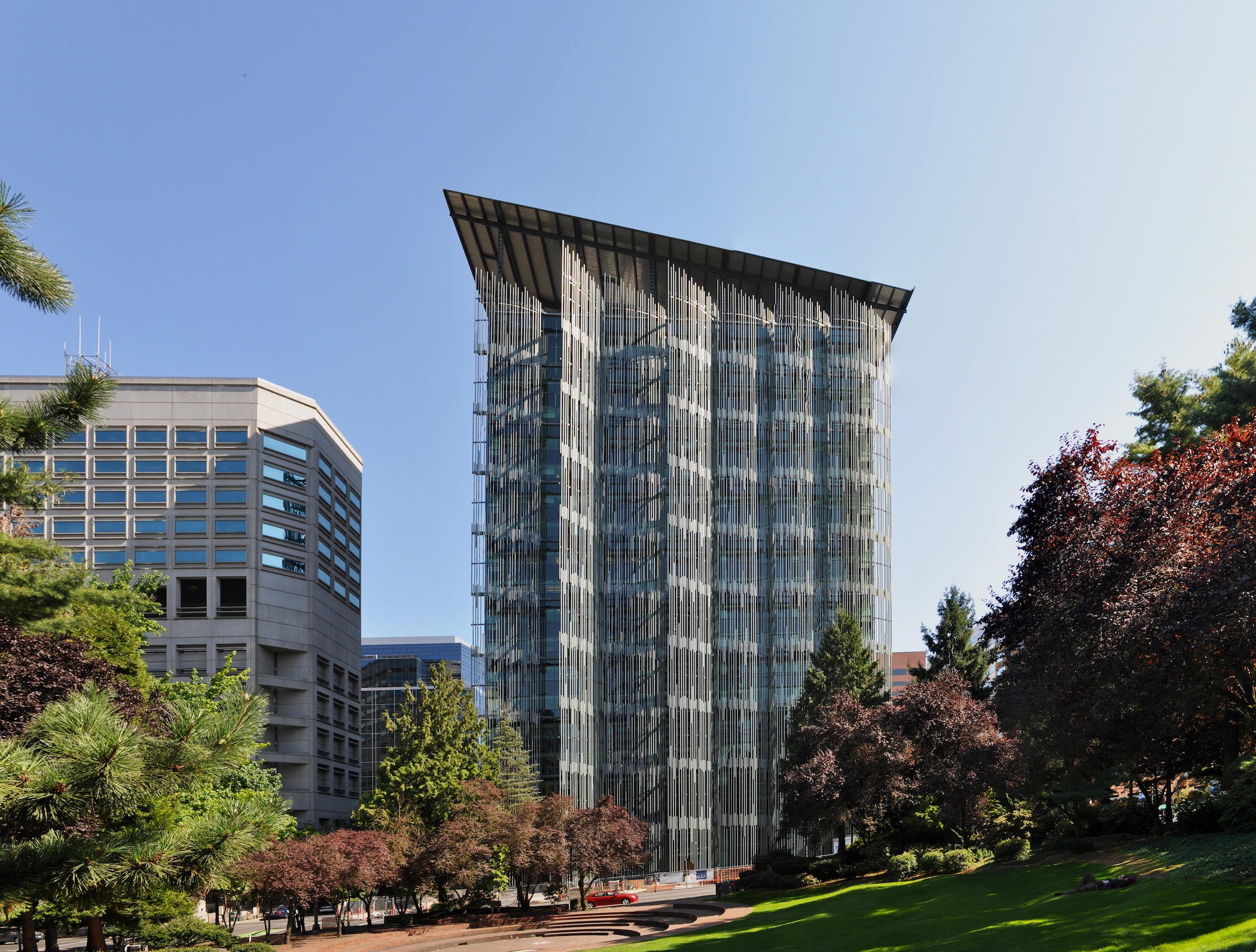
The Edith Green-Wendell Wyatt Federal Building in Portland, Oregon, is an 18-story, 525,000 square foot facility that is home to more than 16 federal agencies and 1,200 federal employees. The building underwent a major renovation between 2009 and 2013.
Today the building is a cornerstone of GSA’s green building portfolio with all new mechanical, electrical, plumbing and data systems designed to make it one of the most energy efficient office buildings in the country.
The newly-renovated Federal Building includes a number of efficient, sustainable and innovative technologies including solar thermal panels, a 13,000 square foot solar roof, modernised elevators that generate power as they descend, unique shading devices on the south, west and east facades designed to respond to the sun conditions, maximise daylight and minimise solar heat gain during the summer, energy efficient electric lighting systems with advanced controls, a 165,000 gallon cistern used to flush low-flow toilets and irrigate native landscaping, energy efficient water fixtures, and a dedicated outside air system that provides 100% fresh air.
The facility is designed to meet the Federal Guiding Principles for High Performing Green Buildings and the Obama Administration’s directives for agencies to lead by example in environmental, energy, and economic performance.
4. Kuyasa Housing Project, South Africa
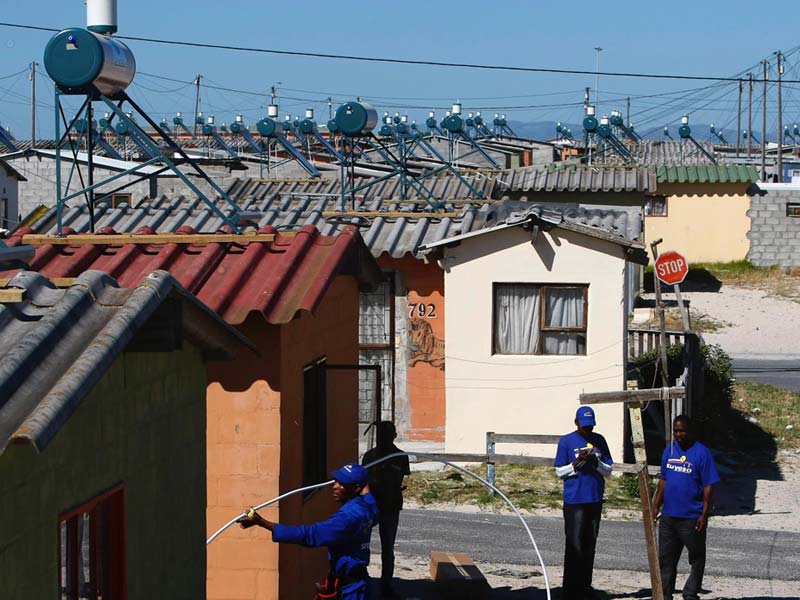
The Kuyasa project is an energy efficiency (EE) retrofit initiative launched in 1999 for 2,309 low-income houses in the outskirts of Cape Town, South Africa. The project included a number of efficient, sustainable and innovative technologies such as solar water heaters, compact fluorescent lamps, ceiling insulation, and energy-efficient cookers.
The project was implemented by the SouthSouthNorth organisation and the City of Cape Town, with funding from the Global Environment Facility (GEF) and the South African Government. It aimed to reduce energy consumption, improve indoor air quality, and reduce greenhouse gas emissions while improving the quality of life of the residents.
5. Caixa Forum Seville, Spain

The Caixa Forum Seville is a cultural centre located in the city of Seville, Spain. The building was originally a 16th-century hospital that was converted into a cultural centre in 2017.
The renovation was designed by Vázquez Consuegra and involved removing the precast concrete façade and installing a high-performance glass curtain wall. The building’s fresh new face reduces solar heat gain, tightens the building’s seal, and radiates sustainability. The team knew early in the process that the uninsulated, precast concrete panels had to go. The building is now a space for art exhibitions, concerts, and other cultural events.
Final Thoughts: The Future of Building Rehabilitation in a Sustainable World
As we navigate our way forward in an increasingly environmentally focused society, the concept of building rehabilitation hones its importance. Efficient building rehabilitation is no longer an option, but an urgent imperative in the face of climate change, and dwindling natural resources.
Within this context, sustainable architecture plays a crucial role. It is the fulcrum on which the benefits of rehabilitation hinge. It ensures not just a building's longevity and operational efficiency, but also its positive impact on the environment and the community that it serves.
What does the future hold?
- With the current pace of technological advancement, the future of building rehabilitation seems promising and intriguing. We will see more inventive and efficient methods of retrofitting and remodelling, fuelled by digital design, smart technologies, advanced materials and more strategic planning.
- The judicious use of energy through active and passive strategies will continue to be at the forefront of building rehabilitation designs. Through the use of energy models, the implementation of these strategies can continue being optimised for enhanced benefits.
- In the future, we’d expect more robust and stringent energy certification standards. This will become a strong driver to gain credibility and maintain compliance as it provides an objective evaluation of a building’s efficiency and sustainability features.
- Encouraging reusable materials and reducing waste, circular construction practices will gain even more traction. Innovations in this field could lead to more practical, profitable, and environment-friendly means to revive buildings.
In conclusion, the opportunities for efficient building rehabilitation are vast and varied. The challenge lies in fostering a mindset and a culture that considers sustainability as a top priority. Therefore, as architects and construction professionals, the onus is on us to design creatively within nature's limits, rehabilitate existing buildings intelligently, and contribute to a more sustainable world.
Understand and Apply Building Rehabilitation through our Sustainable Architecture Course
By understanding and applying building rehabilitation, we can create a better future by preserving our built heritage, reducing greenhouse gas emissions, and promoting sustainable development.
That’s a core aspect of our sustainable architecture course, where we give you the tools and strategies you need to apply building principles, strategies, and techniques for circular economy-based design.

